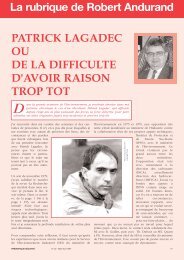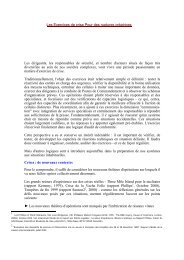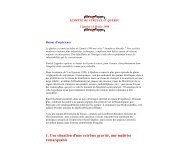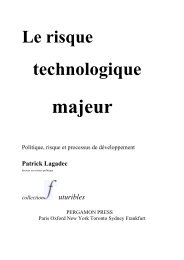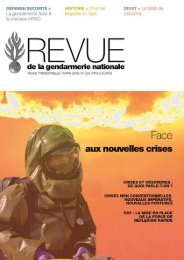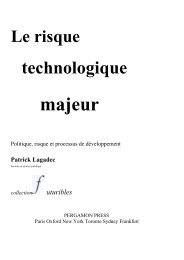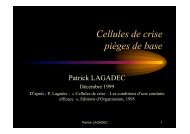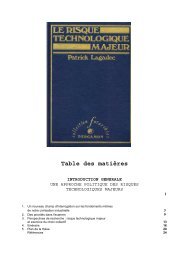STATES OF EMERGENCY - Patrick Lagadec
STATES OF EMERGENCY - Patrick Lagadec
STATES OF EMERGENCY - Patrick Lagadec
Create successful ePaper yourself
Turn your PDF publications into a flip-book with our unique Google optimized e-Paper software.
14 Technical breakdown, crisis and destabilizationUncertainty: grasping for factsData is generated at top speed, but it is hard to collect and interpret. Anoverwhelming snowball effect dominates the situation: even as more andmore information floods in, growing doubts appear as the accident unfolds.The scenario typically takes this shape: we don't know exactly what productshave been released; we don't know in what quantities; we cannot say howmany people have been exposed to the substance; the effects on human beingsare unknown; we have thresholds for long-term situations, but don't knowwhat is acutely tolerated. With that, what basis is there for making immediatedecisions? How can people be expected to wait days and weeks for laboratoryanalyses to be done? How much trust can we have in the results? What aboutapparently aberrant results? What do we make of the last-minute hypothesisthat brutally alters all the accepted criteria? How do we single out thecompetent expert among the flock of specialists who inevitably appear on thedoorstep? Chance, the exception, and calculated risk seem to replace ofaverages, rationales, and optimization.Everyone remembers the problems that emerged at Seveso and Three MileIsland. And Bhopal was no exception: the effects on humans of the gasreleased into the atmosphere were poorly understood; no one knew, at least atthe time, exactly what chemicals were involved; some even wondered whetherthe substance was modified by the leakage process or after inhalation by thevictims. The result was a murky debate on the presence of cyanide-basedcompounds. We can sense how destabilizing such questions can be when theissue of water table contamination in a major urban agglomeration arises, asit did when a French electric utility transformer burned near Lyons on June29 and 30, 1986, releasing 300 liters of PCB-loaded askarel into the ground.The same issue of scientific uncertainty made press headlines when theMont Louis sank on August 25, 1985, taking with it its cargo of uraniumhexafluoride. The event was to arouse vigorous controversy: just what werethe risks? Much time was needed before a clear and coherent view of thesituation could be constructed.The Mont Louis sinking and risks from drums of uranium hexafluoride: in a dispatchdated August 26 (7:43 pm), Agence France Press (AFP) stated, "Uranium hexafluoride(UF6) is a highly toxic and extremely corrosive compound used to produce enricheduranium, the raw material of the nuclear power industry. UF6 is made highly corrosiveby the presence of fluoride, the most aggressive element of this salt compound, and ittherefore reacts strongly with most materials, especially in presence of hydrogen-basedproducts, including water. When this substance is handled in nuclear power plants, thegreatest care is used, and all humidity is avoided." Meanwhile the CEA (commissionfor atomic energy) spoke in terms of a gas (AFP dispatch at 6:48 pm the same day).Clearly the circumstances of the incident - non-nuclear, with primary responsibilityfalling on a shipper unaccustomed to crisis management, taking place outside the ship'shome country on a Saturday - all contributed to internal communication problems inthe official network. In particular, it was impossible at first to find the expert chemicalspecialists who could have explained that (1):- the steel containers, tested at 15 bars, were actually underpressured (0.1 bar),



